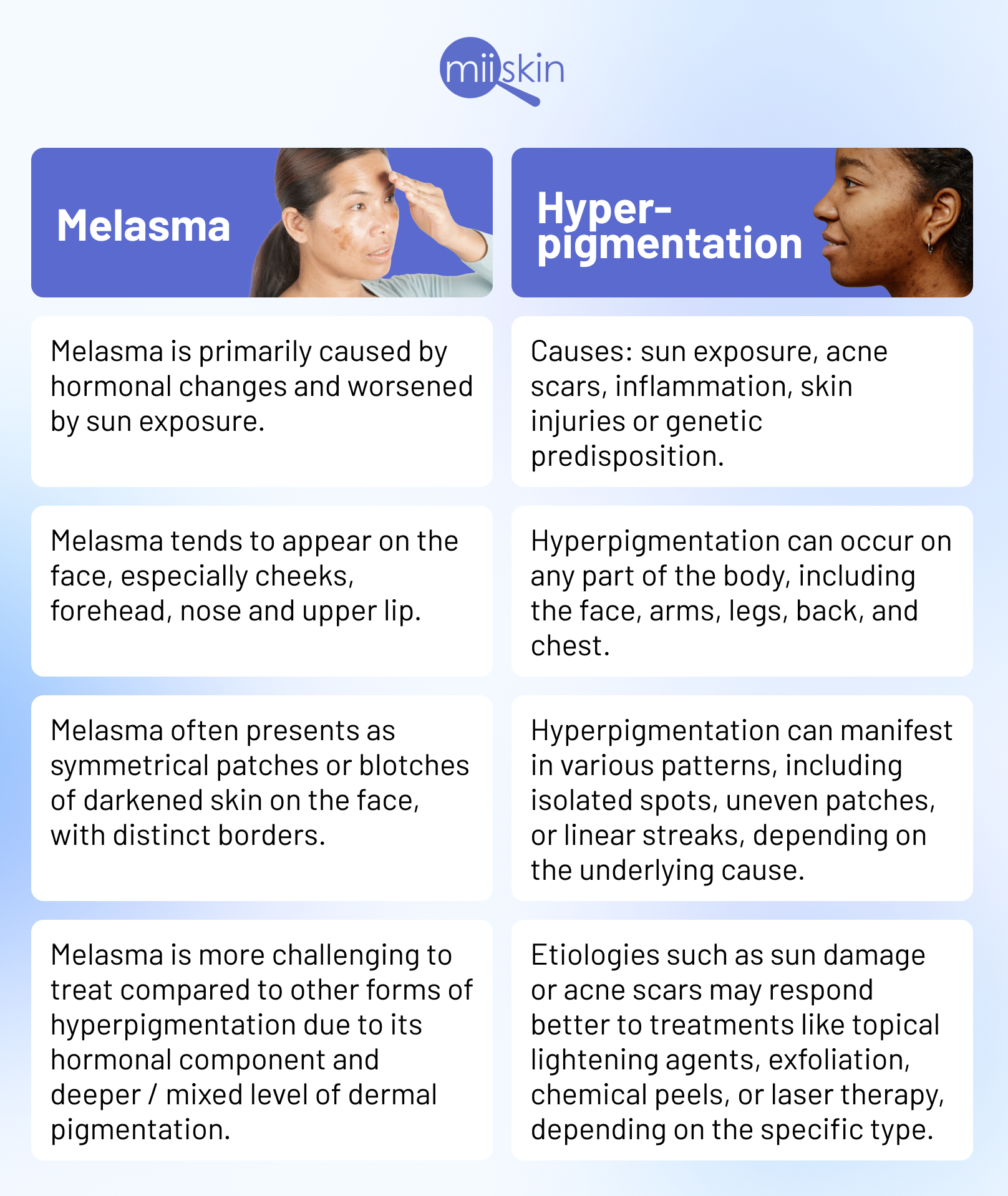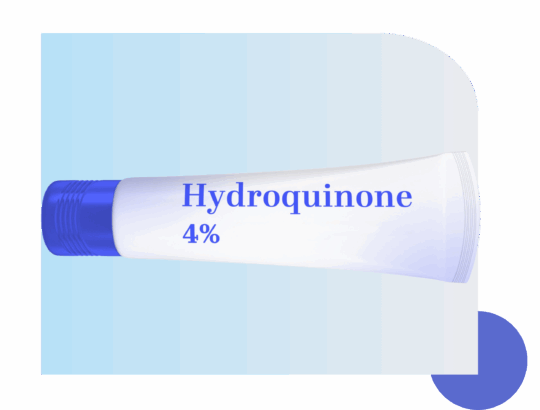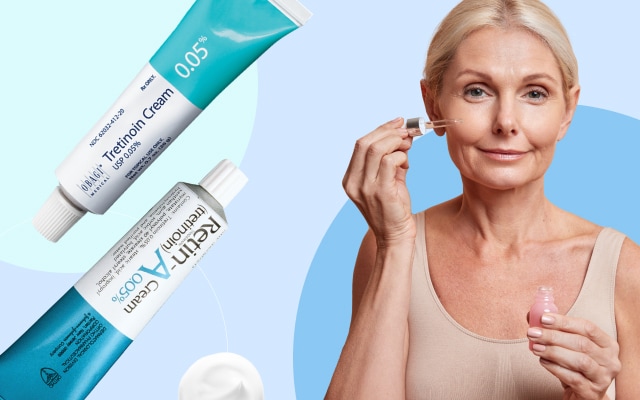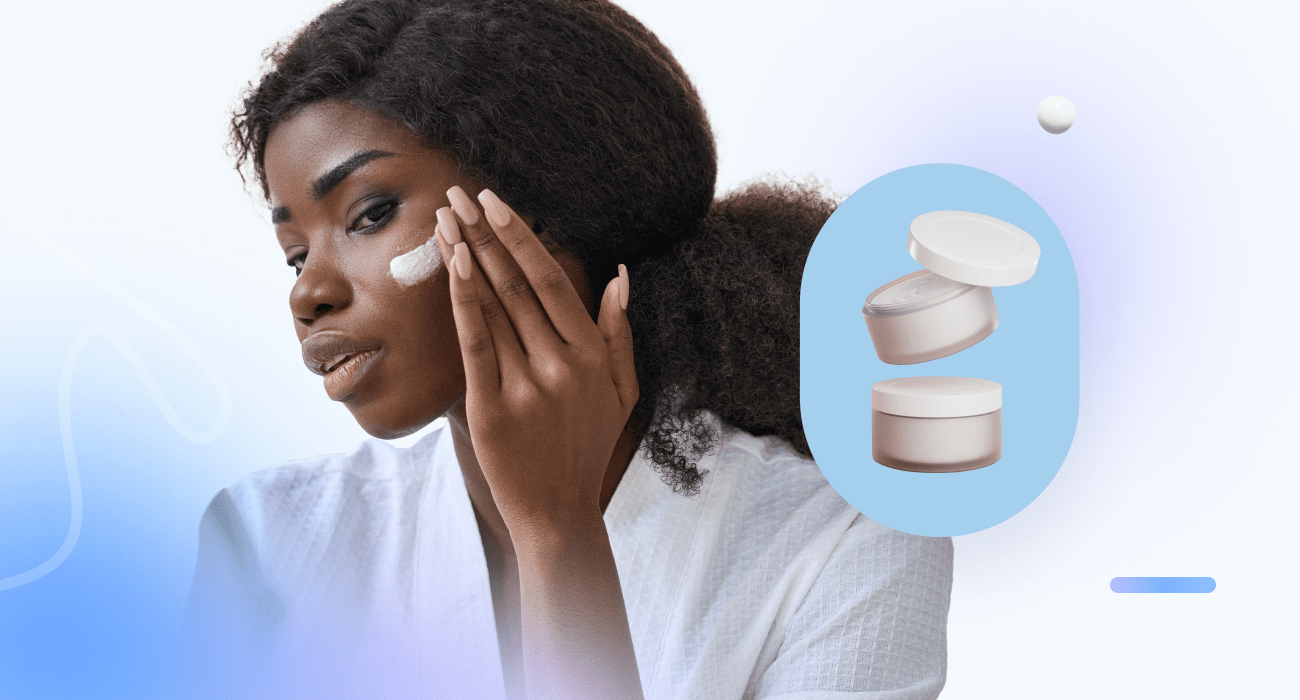Melasma vs hyperpigmentation: Differences and treatment
Understand the differences between melasma and hyperpigmentation, two common skin conditions characterized by darkened patches of skin and learn how to treat them effectively.
Table of Content:
What is melasma and hyperpigmentation? | What is the best treatment? | How to get a prescription? | The differences | Causes | Types of hyperpigmentation
Our commitment to producing high-quality content:
The information presented in this article is based on scientific research and the professional advice of our Content Medical Reviewers, who are experts in the field of Dermatology. How we write our content →
What is hyperpigmentation and melasma?
Hyperpigmentation refers to any discoloration of the skin such as freckles, age spots, post-inflammatory hyperpigmentation from acne, sun damage, or melasma. Hyperpigmentation is a very common condition that results in the darkening of specific skin areas due to an excessive production of melanin. This excess of melanin causes spots or patches on the skin that range from brown, black, gray, to red or pink1.
While these areas typically do not cause any discomfort, they can have significant cosmetic consequences that can greatly impact a person’s self-esteem. Fortunately, a combination of lifestyle adjustments and treatments can prevent and treat existing hyperpigmentation.
Melasma is a hyperpigmentary disorder that is typically caused by hormonal influences and is dramatically worsened by ultraviolet (UV) and visible light2.
What is the best treatment for hyperpigmentation and melasma?
Dr. Williams says that the best treatment for hyperpigmentation and melasma is a dermatologist compounded formula, which blends hydroquinone, tretinoin, and a mild corticosteroid into one powerful prescription cream sold under the brand name Tri-Luma. Hydroquinone reduces excess melanin production, tretinoin boosts cell turnover to fade dark spots more quickly, and the corticosteroid helps calm irritation and enhance tolerability. Together, they target pigmentation from multiple angles, making this dermatologist-recommended formula the most effective and clinically proven option for achieving clearer, brighter, and more even-toned skin.
How can I get a prescription for dark spots?
To request a prescription for dark spots you can start a consultation with a virtual dermatologist, they will be able to assess your condition and issue a prescription. First-time consultations start at $59, and medication refills are only $39. You will get an answer in 1-2 business days. Once your prescription is issued you can order it via an online pharmacy.
Melasma vs hyperpigmentation: the differences

Causes of hyperpigmentation
According to Dr. Ben Williams, dermatologist, a combination of multiple factors contribute to the development of hyperpigmentation such as sun exposure, hormonal influences, age, and medications among others.
Sun exposure
Exposure to the sun is the most common cause of primary hyperpigmentation as it directly stimulates melanin production3. It can also worsen the appearance of the rest of hyperpigmentary disorders listed below which is why daily sunscreen is paramount as step one of anyone’s skincare routine.
Hormonal factors
Hormonal influences, particularly in women, can lead to hyperpigmentation that can be either superficial or deeper in the skin. Conditions such as chloasma or melasma are examples where hormones\ such as estrogen and progesterone can directly stimulate melanin production. One real world example is, when these hormones are increased during pregnancy, conditions such as melasma may significantly worsen4.
Aging
Age spots, also known as liver spots or solar lentigines, can result in localized hyperpigmentation, often associated with a background of photo-aging.
Although as we age melanocyte count tends to decrease, chronic ultraviolet (UV) radiation from the sun can cause localized proliferation of melanocytes and thus an abnormal localized melanin accumulation giving rise to these hyperpigmented spots in sun-exposed areas. This is just another reason reiterating the importance of UV sunlight protection5.
Genetics
Genetics may also play a role in determining generalized as well as localized differences in skin color as well as the function of melanocytes6. There may be localized patches of skin that are affected either through heritable traits passed down or through mutations that occur randomly in certain areas of the skin after conception.
Post-inflammatory hyperpigmentation (PIH)
Skin inflammation or injury from acne, burns, wounds, psoriasis, and atopic dermatitis can lead to post-inflammatory hyperpigmentation. This occurs when the skin becomes darker after the injury has healed7 8 .
Medication-induced
Some medications such as antibiotics (minocycline), birth control pills (hormonal aberrations from baseline), antimalarials (hydroxychloroquine), and tricyclic antidepressants, may cause their own unique type of hyperpigmentation9. These side effects may range in color from brown to blue or gray depending on the drug.
Types of hyperpigmentation
Melasma
Melasma is a type of hyperpigmentation that appears as patches in light brown, dark brown, or blue-gray hues on your skin. These patches can look like flat areas or freckle-like spots in the face, especially the cheeks, upper lip, forehead, and even the forearms14 15 .
Melasma (also called chloasma) is often referred to as the “mask of pregnancy” since it tends to happen quite often during pregnancy. Over time, melasma often darkens in the summer due to sun exposure and lightens in the winter16.
Causes of melasma
According to Dr. Williams, the precise cause of melasma is not yet fully understood and likely multifactorial. However, there are a few factors that contribute to its development.
- Genetic predisposition to melasma, as at least one-third of patients report other family members being affected
- UV radiation, primarily from sun exposure, is a significant exacerbating factor for melasma
- Hormonal changes play a role in melasma such as Pregnancy and the use of hormonal contraceptives can also be a contributing factor17.
Freckles or “Ephelides”
Freckles are small, concentrated areas of hyperpigmentation often seen on fair-skinned individuals. They result from an uneven distribution of melanin in response to sun exposure11.
Sunspots or “Solar lentigines”
These are flat, darkened areas on the skin caused by prolonged sun exposure. They are a localized type of hyperpigmentation that commonly appears on sun-exposed areas like the face and hands12.
Post-inflammatory hyperpigmentation (PIH)
PIH occurs after an injury or inflammatory process in the skin, such as acne, burns, or insect bites. It leads to darkened areas as a result of increased melanin production during the healing process13.
How to prevent hyperpigmentation and melasma?
Although you cannot fully prevent the development of some hyperpigmentary disorders such as melasma, according to Dr. Williams, you can do three things to reduce the chance of developing or worsening this condition.
- Minimize direct sun exposure between the hours of 10am-2pm, wear UV sun protective clothing, and always apply sunscreen with a broad spectrum SPF of 30 or higher reapplying every 2 hours while outdoors. For conditions such as melasma, I would recommend a tinted sunscreen with iron oxide to be worn daily even while indoors since visible light (the light all around us) including blue light from computer screens also contributes to worsening of pigmentation. Iron oxide based sunscreens are essential for this additional protection against blue light.
- Consider alternative birth control methods if you are susceptible to melasma, as conventional birth control pills may exacerbate the condition. For this, I would recommend a consultation with a dermatologist who can work with your primary provider to pick the best option based on one’s individualized needs.
- Utilize appropriate skincare products as some may lead to skin irritation thus worsening pigmentation. For example, some chemical peels or high strength retinoids may initially cause a localized irritant dermatitis (the latter referred to as a retinoid dermatitis) which may cause paradoxical temporary hyperpigmentation or worsening of existing pigmentary disorders.
The takeaway
Although in many cases it is not possible to get rid of hyperpigmentation and melasma completely, today’s prescription topical treatments can help you reduce their appearance considerably. Having a consultation with a virtual dermatology provider in your state will help you get a more even skin tone.
You can also combine topical treatment with laser or chemical peels. Find a local dermatologist in your area that offers these services.
Lee este artículo en Español ¿Melasma o hiperpigmentación? Diferencias y tratamiento






 Get a custom formula for dark spots!
Get a custom formula for dark spots!